Paul Klee
dal 24/10/2008 al 31/1/2009
Segnalato da
24/10/2008
Paul Klee
Museum der Moderne, Salzburg
The exhibition is dedicated to Paul Klee's intensive involvement with music, with melody, rhythm and polyphony, as well as with dance: these topics represented central elements in his work, in terms of both content and form. The aspect of melody is condensed, in the way it is implemented in the form of a line on a picture; the line unfolds its own musicality in Klee's drawing work. The aspect of rhythm makes structural analogies evident in design processes, in the depiction of bar sequences or uperimposed layers of area patterns and colour patterns.

The exhibition “Paul Klee. Melody/Rhythm/Dance” is dedicated to Paul Klee’s (1879—1940) intensive involvement with music, with melody, rhythm and polyphony, as well as with dance: these topics represented central elements in his work, in terms of both content and form. Music was fundamental to Paul Klee’s artistic life: he played violin extremely well and attended operas and concerts with great enthusiasm; he also wrote sharply-phrased, unsparing musical critiques. For a long time he was undecided as to whether he wished to become a painter or a musician. He characterized music in his diary as his “lover”, painting as his “goddess of the brushes, smelling of oil and whom I only embrace because she is my wife”.
The aspect of melody is condensed, in the way it is implemented in the form of a line on a picture; the line unfolds its own “musicality” in Klee’s drawing work. The aspect of rhythm makes structural analogies evident in design processes, used in both visual and musical artistic works, in the depiction of bar sequences (two-bar, three-bar, six-bar etc.) or superimposed layers of area patterns and colour patterns. This pictorial involvement with musical modes of composition finds its high-point in multi-voiced, “polyphonous” structures for pictures, which indeed represent an invention made by the artist for his pictures.
Many of Klee’s works relate to opera, which he loved above all else. Subjects taken as source materials for works included famous characters from operas by Mozart, Rossini or Verdi, as well as a comprehensive assembly of orchestral instruments — percussion, wind and string instruments — and their musicians. Constructed in individual “chapters”, the exhibition cuts a broad sweep across Klee’s body of work, including topics of interest and relevance for the musical city of Salzburg, such as “Paul Klee and Mozart” and the music-related manuscripts from his “educational legacy”.
One topic, taken up as an opener, is Klee’s different way of approaching music and the way it is portrayed in pictorial terms, compared to important artistic contemporaries from the realm of Bauhaus — with works from Vassily Kandinsky, Johannes Itten, Josef Matthias Hauer and others; this serves as an introduction to the principal topic itself. The emphasis in the exhibition is on works from the Zentrum Paul Klee’s collection and his estate. With over 200 exhibits, the exhibition draws together numerous works, from international collections in museums and private ownership, with a series of documents (photographs, letters etc.): these afford access to Paul Klee as a person and an insight into the artist’s theoretical involvement with the subject of music, as well as materials from Klee’s teaching work with Bauhaus, which are works of art in themselves.
Opening: Sat, 25/10/08, 11 am
Museum der Moderne
Moenchsberg 32, Salzburg



